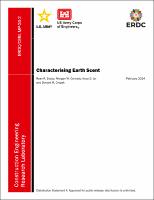Please use this identifier to cite or link to this item:
https://hdl.handle.net/11681/48262| Title: | Characterising earth scent |
| Authors: | Busby, Ryan R. Conrady, Morgan W. Jo, Kyoo D. Cropek, Donald M. (Donald Michael) |
| Keywords: | 2-methylisoborneol Biogenic emissions Earth scent Geosmin Soil disturbance Soil volatilome Solid-phase microextraction Volatile organic compounds |
| Publisher: | Engineer Research and Development Center (U.S.) |
| Series/Report no.: | Miscellaneous Paper (Engineer Research and Development Center (U.S.)) ; no. ERDC/CERL MP-24-2 |
| Is Version Of: | Busby, Ryan R., Morgan W. Conrady, Kyoo D. Jo, and Donald M. Cropek. "Characterising earth scent." Environmental Chemistry 20, no. 5 (2023): 226-234. https://doi.org/10.1071/EN23087 |
| Abstract: | Rationale. Earth scent is the odour emitted from soils. This scent, primarily comprising the alcohols geosmin and 2-methylisoborneol (MIB), has not been fully characterised, but offers high potential for use as an environmental interrogation tool. Methodology. We utilised our field- based, solid-phase microextraction fibre method to test the hypothesis that soil activity and soil property variation can be detected in situ by comparing biogenic volatile emissions. Results. We eliminated sources of error utilising field-based sampling with these fibres, concluding that room temperature storage for up to 7 days is acceptable with minimal loss. Variation in individual fibre affinity for both compounds was higher than expected but no measured concentrations were observed to constitute outliers. Disturbance of minor soil volumes led to significantly higher emission of both compounds over background levels. Soil texture and soil cover had a significant effect on the emission of both compounds. Simulated rainfall, producing the characteristic odour known as petrichor, initiates elevated emission of geosmin. Background (undisturbed soil) concentrations of MIB were occasionally detectable during some sampling events, but geosmin concentrations in the air were always below detection limits without soil disturbance. Virtually all background and disturbed soil samples contained much higher concentrations of MIB compared to geosmin, but geosmin variation between replicates and experimental units was much lower. Discussion. Soil disturbance and soil property variation can be remotely detected using emission of volatile compounds. Correlating emission from the soil with respect to disturbance events and environmental properties could yield a powerful new tool for acquiring soil information. |
| Description: | Miscellaneous Paper |
| Gov't Doc #: | ERDC/CERL MP-24-2 |
| Rights: | Approved for Public Release; Distribution is Unlimited |
| URI: | https://hdl.handle.net/11681/48262 http://dx.doi.org/10.21079/11681/48262 |
| Appears in Collections: | Miscellaneous Paper |
Files in This Item:
| File | Description | Size | Format | |
|---|---|---|---|---|
| ERDC-CERL MP-24-2.pdf | 1.54 MB | Adobe PDF |  View/Open |